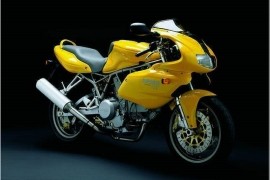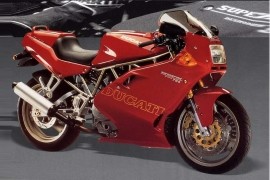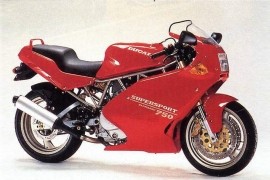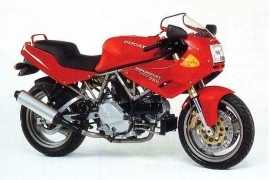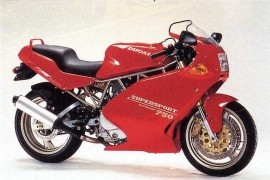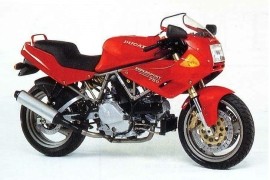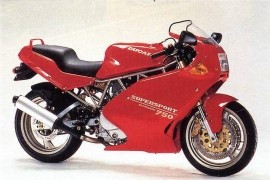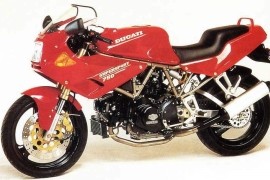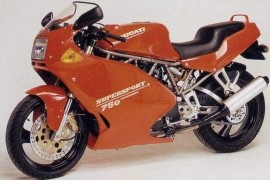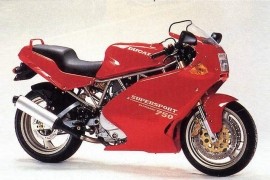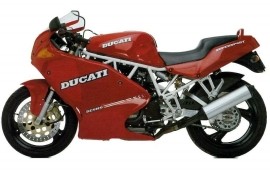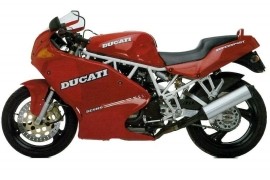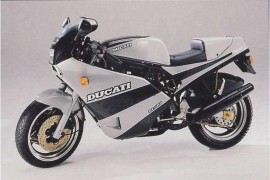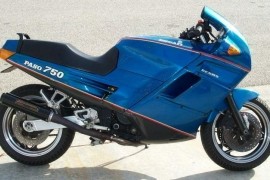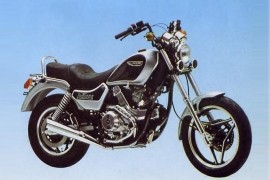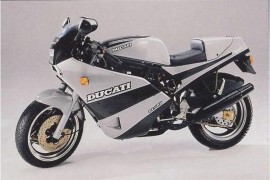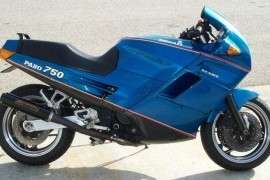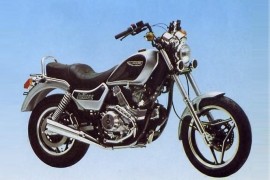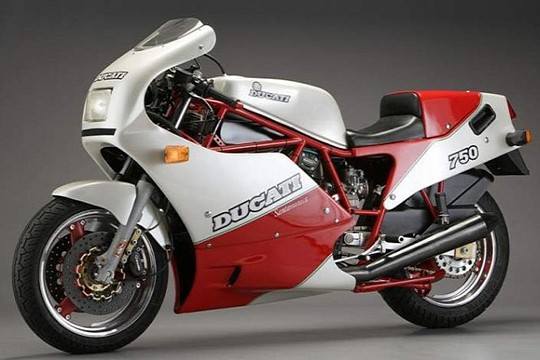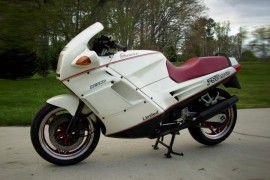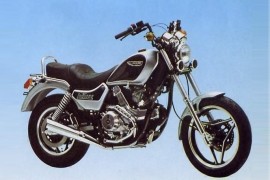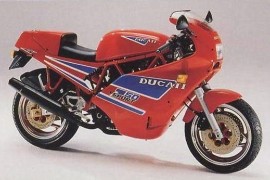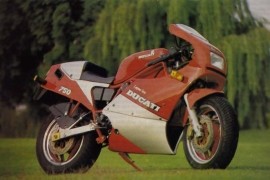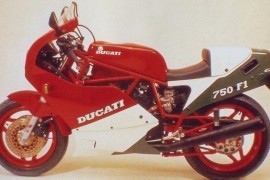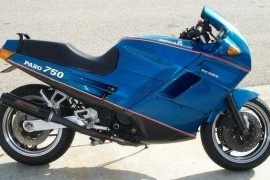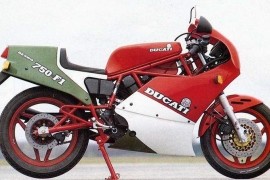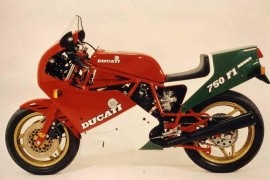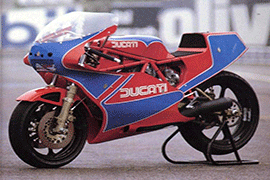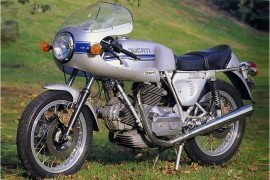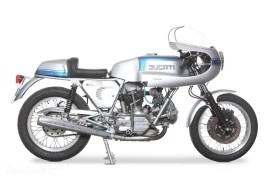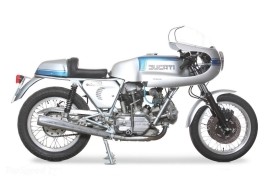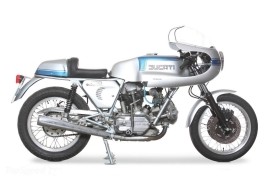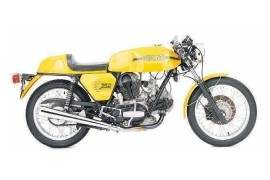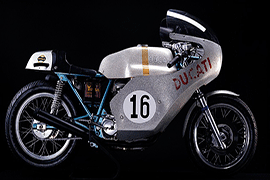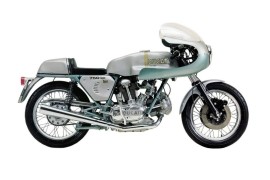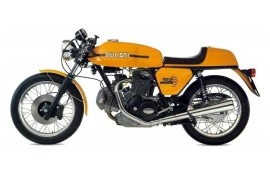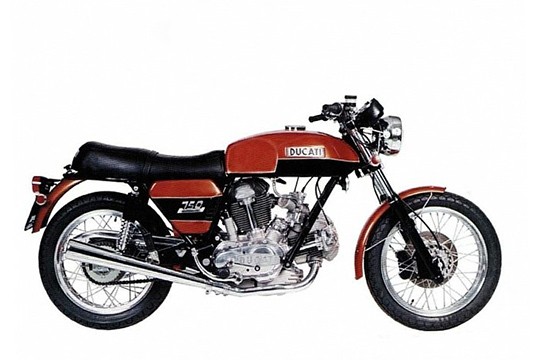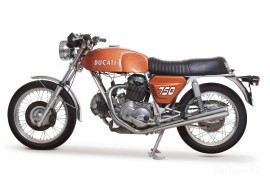DUCATI 750 Models/Series Timeline, Specifications & Photos
First production year: 1971
In 2000, the Italian motorcycle manufacturer released the Ducati 750SS I.E., a half or fully dressed sports motorcycle. The bike featured a fuel injected engine and delivered slightly more power than the previous models.
In the visual department, the motorcycle packed standard features, such as a half or full fairing with a single headlight unit, a small windscreen, a dual exhaust system with a silencer on each side, a one-piece double seat with a pillion grab handle, and lightweight three-spoke aluminum wheels.
The bike's suspension system comprised a 43 mm fully adjustable Showa inverted fork on the front, providing 120 mm of travel, and an adjustable Sachs Boge shock absorber on the rear, delivering 136 mm of travel.
In the braking department, the machine was fitted with a Brembo braking system, comprised of two 320 mm discs on the front wheel engaged by four-piston calipers and a 245 mm disc on the rear wheel squeezed by a dual-piston caliper.
The 2000 Ducati 750SS I.E. had its soul brought to life by a 748cc four-stroke air-cooled V-twin engine managed by a fuel injection system, delivering an output power of 64 hp with a peak force at 8,250 rpm and 62 Nm (46 lb-ft) torque at 6,000 rpm.
The power was transferred to a five-speed manual transmission with a wet multi-plate clutch and redirected to the rear wheel via a final chain drive.
In 2001, the Italy-based motorcycle manufacturer launched the Ducati 750 Sport I.E., a sports machine in an agile package suited for a variety of rider-level experiences and different ages.
The new 2001 model was sold worldwide and packed several improvements, including a smaller and lighter sealed battery, a half fairing, a gray seat, a tank protector, an integrated brake reservoir and clutch master cylinders, and the lack of air intakes on the fairing.
The bike's visual aspect was characterized by standard features, such as three-spoke lightweight cast-aluminum wheels, a one-piece dual seat with a passenger grab handle, a top fairing with a single headlight unit, a small windscreen, and a two-into-two exhaust system with a muffler on each side.
The bike was built around a steel frame with a 43 mm inverted Showa fork on the front (from 2002, it changed to 43 mm Marzocchi) and a Sachs Boge shock absorber on the rear, delivering optimum handling capabilities.
The bike was kept on the road by a 320 mm disc on the front wheel coupled to a dual-piston caliper and a 245 mm disc on the rear tied to a two-piston caliper, providing optimum stopping power.
As for the power figures, the 2001 Ducati 750 Sport I.E. took its nerves from a 748cc four-stroke air-cooled V-twin engine with a fuel injection system in charge, boasting 64 hp at 8,250 rpm and 61 Nm (45 lb-ft) torque at 6,000 rpm.
The Ducati Supersport and SS was a series of sports motorcycles in Ducati's range manufactured since 1988, replacing the Pantah model, and produced until 2007 when they were replaced by the Ducati Supersport 950 model.
In 1996, the Italian motorcycle manufacturer launched the Ducati 750SS, a sports motorcycle with the exact technical, visual, and performance specifications as previous models without any significant modification whatsoever.
The bike's appearance was represented by standard fittings, including a full fairing with a medium windscreen, a one-piece dual seat with a passenger grab handle, a dual exhaust system, and lightweight three-spoke aluminum wheels.
The bike retained the same frame and suspension from previous models, including a steel trellis frame, a 41 Showa inverted telescopic fork on the front, and an adjustable Showa shock absorber on the rear, offering excellent handling.
Also, the braking system was retained, including a 320 mm disc engaged by a four-piston caliper on the front and a 245 mm rotor with a two-piston caliper managing the rear wheel, providing optimum stopping power.
In the performance department, the 1996 Ducati 750SS had installed a 748cc air-cooled four-stroke V-twin engine underneath its armor, managed by Mikuni carburetors. As for the power figures, the engine delivered 66 hp with a peak force at 8,500 rpm and 72 nm (53 lb-ft) torque at 6,500 rpm.
In 1995, the Italian motorcycle maker offered the Ducati 750SS Half Fairing alongside the base model. This sports motorcycle shared the same technical and performance specifications as the standard version, except for a half fairing as opposed to the fully faired Ducati 750SS.
Their name harked back to the 1970s Ducati 750 Supersport with the round case and the 1975 square case 750 and 900cc Supersport models. It debuted in 1988 as a replacement for the Pantah model and was produced until 2007, when it was replaced by the Ducati Supersport 950 model.
Visually, the 1995 model had installed standard fittings, such as a single-piece seat with a passenger grab handle, a dual exhaust system, three-spoke lightweight cast-aluminum wheels, a top fairing, a square headlight, and a medium-sized windscreen.
Like previous models, the 1995 Half Faired motorcycle was built around a steel trellis frame holding everything together, including the 41 mm Showa upside-down fork fitted on the front and the adjustable Showa shock absorber mounted on the rear.
At its core, the 1995 Ducati 750SS Half Fairing had installed a 748cc four-stroke V-twin
air-cooled engine with two Mikuni carburetors fueling the pistons, delivering 66 hp at 8,500 rpm and 72 Nm (53 lb-ft) torque at 6,500 rpm.
As for the braking performance, the bike's 17-inch wheels packed a 320 mm disc on the front coupled to a four-piston caliper and a 245 mm disc on the rear, engaged by a dual-piston caliper.
The Ducati 750SS was a sports motorcycle part of the Supersport series in Ducati's range. It debuted in 1988 to replace the Ducati Pantah and continued production until 2007 when the Ducati Supersport 950 model came to replace it.
The bike's name was taken from the 1970s round case Ducati 750 Supersport and 1975 square case 900cc and 750cc Supersport models. The 750SS model was a smaller, more affordable version of the 900cc model.
In 1995, the Italian motorcycle maker launched the Ducati 750SS, a sports machine with the same package as the previous model, delivering the exact technical, visual, and performance specifications without significant modifications.
The bike's aesthetic was represented by factory-fitted standard fittings, such as three-spoke lightweight aluminum wheels with Dunlop Sportmax Radial tires, a full fairing with a windscreen, a large, rectangular headlight, a single-piece seat with a pillion grab handle, and a dual exhaust system with a silencer on both sides.
The 1994 Ducati 750SS had a 748cc four-stroke air-cooled V-twin engine installed underneath its armor. Two Mikuni carburetors managed the engine, delivering an output power of 66 hp at 8,500 rpm and 72 Nm (53 lb-ft) torque at 6,500 rpm.
The bike was teamed by a 320 mm disc mounted on the front wheel engaged by a four-piston caliper and a 245 mm disc installed on the rear end with a dual-piston caliper, offering excellent braking performance.
In 1994, the Italian motorcycle manufacturer launched the Ducati 750SS Half Fairing. As its name says, the bike came with a half fairing as opposed to its fully faired sibling, featuring the exact technical and performance specifications.
In the aesthetic department, the 1994 Half Faired model packed standard features, such as a top fairing with a medium-sized windscreen, a large, rectangular headlight, a single-piece seat with a passenger grab handle, a two-into-two exhaust system with a silencer on each side, and three-spoke lightweight cast-aluminum wheels.
The bike was built around a steel trellis frame with a 41 mm upside-down Showa telescopic fork on the front, providing 119 mm of travel, and an adjustable Showa shock on the rear with 135 mm of travel, delivering excellent suspension performance and handling capabilities.
As for the stopping power, the bike packed a 320 mm disc on the front wheel handled by a four-piston caliper and a 245 mm disc on the rear wheel squeezed by a dual-piston caliper, providing optimum braking performance.
As for power, the 1994 Ducati 750SS Half Fairing took its thrust from a 748cc four-stroke air-cooled V-twin engine managed by two Mikuni carburetors, delivering an output power of 66 hp with a peak force at 8,500 rpm and 72 Nm (53 lb-ft) torque at 6,500 rpm.
With a wet weight of 188 kg (416 lbs) and a five-speed gearbox, the bike reached 220 kph (137 mph).
In 1994, the Italian maker launched the Ducati 750SS, a sports motorcycle part of the Supersport series in Ducati's range. The bike debuted in 1988 as a replacement model for the Ducati Pantah and was produced until 2007, when it was replaced by the Ducati Supersport 950.
It was a smaller version of the 900SS model, packing standard features, including a full fairing with a rectangular headlight on the front, a medium-sized windscreen, a one-piece dual seat with a pillion grab rail, a dual exhaust system with a muffler on each side, and three-spoke lightweight wheels.
As with previous models, the 1994 motorcycle packed the same suspension system, comprising a 41 mm Showa upside-down telescopic fork on the front and an adjustable Showa shock on the rear, bolted to a steel trellis frame.
Also, the braking system was retained from previous machines, packing a single 320 mm rotor on the front wheel engaged by a four-piston caliper and a 245 mm rotor on the rear, squeezed by a dual-piston caliper.
Underneath its clothes, the 1994 Ducati 750SS was hiding a 748cc four-stroke air-cooled V-twin engine with two Mikuni carburetors sending fuel to the pistons, delivering 66 hp with maximum strength at 8,500 rpm and 72 Nm (53 lb-ft) torque at 6,500 rpm.
All the power produced by the engine was transferred to a five-speed gearbox linked to the rear wheel through a chain drive, pushing the machine to 220 kph (137 mph).
In 1993, the Italian motorcycle manufacturer launched the Ducati 750SS Half Fairing alongside the base model. The bike packed the same features as the standard model, except in the visual department, being equipped with a half fairing.
The bike's aesthetic was represented by standard features, including a half fairing with a rectangular headlight and a medium-sized windscreen, a one-piece dual seat with a passenger grab rail, a dual exhaust system with a silencer on each side, and lightweight aluminum three-spoke wheels.
The bike rode on 17-inch wheels and Dunlop Sportmax Radial tires, fitted with a 320 mm disc coupled to a four-piston caliper on the front and a 245 mm disc with a two-piston caliper on the rear.
The steel trellis frame was softened by a 41 mm upside-down Showa telescopic fork on the front, providing 119 mm wheel travel and an adjustable Showa shock on the rear with 135 mm of travel.
As for performance, the 1993 Ducati 750SS Half Fairing packed a 748cc four-stroke V-twin air-cooled engine underneath its fuel tank. Two Mikuni carburetors delivered fuel to the pistons, boasting 66 hp with maximum power at 8,500 rpm and 72 Nm (53 lb-ft) torque at 6,500 rpm.
Paired to the engine, a five-speed manual transmission sucked the power out of the generator, sending it to the rear end through a final chain drive, achieving a top speed of 210 kph (130 mph).
In 1993, the Italian bike maker introduced the Ducati 750SS, a smaller and more agile version of the 900SS. The 1993 model packed the exact technical, visual, and performance specifications as the previous model, without significant modifications, except for minor color changes.
It packed the same standard features as previous models, including a full fairing, a single, rectangular headlight up front, a windscreen for wind protection, a bronze-finished frame, a one-piece dual seat with a pillion grab handle, a dual exhaust system, and three-spoke blacked-out wheels.
The bike was built around a steel trellis frame with a 41 mm upside-down Showa telescopic fork on the front, offering 119 mm of travel, and an adjustable Showa shock absorber on the rear, delivering 135 mm of travel.
As for the braking power, the 1993 machine packed a 320 mm disc with a four-piston caliper on the front wheel and a 245 mm disc with a dual-piston caliper on the rear wheel, offering optimum braking power.
The 1993 Ducati 750SS had its heartbeat set by a 748cc four-stroke air-cooled V-twin engine fed by Mikuni carburetors, boasting 66 hp at 8,500 rpm and 72 Nm (53 lb-ft) torque at 6,500 rpm.
Like previous models, the bike packed the same gearbox linked to the rear wheel through a chain drive, pushing the motorcycle to 210 kph (130 mph).
In 1992, the Italian motorcycle manufacturer launched the Ducati 750SS Half Fairing, a motorcycle that combined supersport performance and wind protection with a naked machine's comfortable riding position and agility.
It came with the same standard features as the base model, including a one-piece dual seat with a passenger grab handle, a dual exhaust system with a silencer on each side, blacked-out three-spoke aluminum wheels, and a half fairing instead of a full unit.
The bike's steel trellis frame offered mounting points for a 41 mm inverted Showa telescopic fork on the front end and an adjustable Showa shock absorber on the rear, providing optimum handling capabilities.
In the braking department, the bike's wheels were fitted with a 320 mm disc engaged by a four-piston caliper on the front and a 245 mm rotor with a dual-piston caliper on the rear, offering excellent stopping power.
The 1991 Ducati 750SS Half Fairing had installed a 748cc four-stroke V-twin air-cooled engine at its core, managed by two Mikuni carburetors. As for the power figures, the engine boasted 66 hp with a peak force at 8,500 rpm and 72 Nm (53 lb-ft) torque at 6,500 rpm.
The bike's 188 kp (416 lbs) wet weight, a five-speed manual transmission, and a final chain drive pushed the bike to a top speed of 210 kph (130 mph).
In 1992, the Italian bike maker launched the Ducati 750SS, a sports motorcycle dressed in a full fairing, unlike its half-faired sister of the same year. The bike was agile and offered a comfortable riding position complemented by crispy performance.
In the visual department, the motorcycle had installed standard features, such as a full fairing with a rectangular headlight, a medium windscreen, a one-piece double seat with a passenger grab rail, a twin exhaust system with a muffler on each side, and lightweight three-spoke aluminum wheels.
All bits and pieces were mounted on a steel trellis frame, including the 41 mm inverted Showa fork on the front that handled the front suspension and the adjustable Showas shock on the rear that took care of the rear suspension.
The bike's three-spoke alloy wheels were fitted with a 320 mm brake disc on the front coupled to a four-piston caliper. The rear wheel was handled by a 245 mm brake disc squeezed by a two-piston caliper.
The 1992 Ducati 750SS took its muscles from a 748cc four-stroke air-cooled V-twin engine managed by two Mikuni carburetors. As for the power figures, the bike developed 66 hp with maximum strength at 8,500 rpm and 72 Nm (53 lb-ft) torque at 6,500 rpm.
With a wet weight of 188 kp (416 lbs), a five-speed manual transmission, a wet multi-plate clutch, and a final chain drive, the bike reached a top speed of 210 kph (130 mph).
The Ducati Supersport and SS was a series of sports motorcycles in Ducati's range manufactured since 1988 as a replacement model for the Pantah model. The bikes were produced until 2007, when they were replaced by the Ducati Supersport 950 model.
The name was reminiscent of the 1970s Ducati 750 Supersport with the round case and the 1975 square case 750 and 900cc Supersport models. In addition, the maker released a limited edition machine in 1992 named the Superlight.
In 1991, Ducati released the Ducati 750SS model, packing the same specifications as previous models without any significant modification whatsoever.
Packing the same engine as previous models, the 1991 Ducati 750SS boasted 66 hp with maximum strength at 8,500 rpm and 72 Nm (53 lb-ft) torque at 6,500 rpm from a 748cc four-stroke V-twin air-cooled power plant.
The power produced by the engine was transferred to a five-speed transmission with a manual dry multi-plate clutch. From there, it was delivered to the rear wheel through a chain drive, pushing the motorcycle to a maximum speed of 210 kph (130 mph).
In the suspension department, the bike had a 40 mm Marzocchi inverted telescopic fork on the front end. The rear end was handled by an adjustable Showa shock absorber.
In the braking department, the bike relied on a 320 mm disc with a four-piston caliper stopping the front wheel and a 245 mm rotor tied to a dual-piston caliper handling the rear wheel.
In 1990, the Italian motorcycle maker released the Ducati 750SS, a sports motorcycle in its third year of production. Without significant modifications, it featured the same technical, performance, and visual specifications as the previous model.
The Ducati Supersport and SS was a series of sports motorcycles that debuted in 1988 to replace the Pantah model and were produced until 2007, when they were replaced by the Ducati Supersport 950 model.
Visually, the 1990 model had factory-installed features, like a full fairing with a medium windscreen, a one-piece dual seat with a passenger grab handle, a dual exhaust system, and lightweight three-spoke aluminum wheels.
The bike was manufactured around a steel trellis frame, wearing a 40 mm Marzocchi inverted telescopic fork on the front end and an adjustable Showa shock absorber on the rear, acting as the bike's suspension system.
The bike's braking power was handled by a single 320 mm disc with a four-piston caliper mounted on the front wheel and a 245 mm rotor tied to a dual-piston caliper on the rear wheel, providing optimum braking performance.
As for the power figures, the 1990 Ducati 750SS had at its core a 748cc four-stroke V-twin air-cooled engine managed by two Mikuni carburetors, boasting 66 hp at 8,500 rpm and 72 Nm (53 lb-ft) torque at 6,500 rpm.
With a five-speed manual transmission sending the power to the rear axle through a final chain drive, the bike reached a top speed of 210 kph (130 mph).
The Ducati Supersport and SS was a series of sports motorcycles manufactured by Ducati since 1988, replacing the Pantah model, and produced until 2007 when they were replaced by the Ducati Supersport 950 model.
Their name harked back to the 1970s Ducati 750 Supersport with the round case and the 1975 square case 750 and 900cc Supersport models. In addition, in 1992, the maker released a limited edition machine named the Superlight.
In the aesthetic department, the motorcycle had standard features, like a full fairing with a medium-sized windscreen, a one-piece dual seat with a passenger grab handle, a dual exhaust system, and lightweight three-spoke aluminum wheels.
The bike's suspension system comprised a 40 mm Marzocchin inverted fork on the front and an adjustable Showa shock absorber on the rear, offering optimum handling capabilities and suspension performance.
The braking power was handled by a 320 mm disc on the front wheel tied to a four-piston caliper and a 245 mm disc on the rear end engaged by a dual-piston caliper, providing optimum stopping performance.
As for power, the 1989 Ducati 750SS had installed a 748cc four-stroke air-cooled V-twin engine underneath its fuel tank, delivering 66 hp with maximum strength at 8,500 rpm and 72 Nm (53 lb-ft) torque at 6,500 rpm.
The engine was married to a five-speed manual transmission that sent the power to the rear wheel through a final chain drive.
The Italian engineers from Ducati have designed the 1990 MY 750 Sport model for riders who want superior performance from their machine, but in a light and agile package, capable of tackling joy rides in the weekend, as well as a track Sunday, with ease. It sports a liquid-cooled, four-stroke, 748cc, 90-degree V-Twin powerhouse mated to a five-speed manual transmission, and can produce a claimed 75 horsepower and 70 Nm of torque.
Also, it comes with a 40mm Marzocchi telescopic front fork coupled to a Marzocchi monoshock as a rear suspension, a Brembo braking system with dual front discs and a single disc in the rear, a full-fairing with a small windscreen, cast-aluminium wheels, analogue instrumentation dials, a single seat, a blacked-out exhaust system and a steel trellis frame.
In 1989, the Italian bike maker Ducati released the Ducati 750 Paso, a fully-dressed sports motorcycle that retained the same package as previous models without any significant modifications whatsoever.
The bike debuted in 1986 under the "Il nostro passato ha un grande futuro" (Our past has a great future) slogan. The bike's name was chosen in honor of Renzo Pasolini, a racer who died on May 20, 1973, in an accident during the Grand Prix at the Monza racetrack. The racer's nickname was Paso, hence the bike's designation.
Also, in 1989, the maker introduced the Ducati Paso 906, a bike with a six-speed transmission and a larger engine that delivered 88 hp and a maximum speed of 220 kph (137 mph) to replace the Ducati 750 Paso.
The 1989 Ducati 750 Paso had its heartbeat set by a 748cc four-stroke air-cooled V-twin engine that delivered an output power of 73 hp with a peak force at 7,900 rpm and 50 Nm (37 lb-ft) torque at 6,350 rpm.
The bike was built around a steel frame with a 42 mm Marzocchi telescopic fork on the front and an adjustable shock absorber on the rear, providing optimum suspension performance and handling capabilities.
As for the stopping power, the bike relied on two 280 mm discs with dual-piston calipers on the front wheel and a 270 mm rotor with a two-piston caliper on the rear wheel.
The Indiana was a motorcycle manufactured by Ducati from 1986 to 1988 in a total production of 2,318 units. The bike was developed due to Cagiva’s desire to compete with Harley-Davidson on their own turf.
The first motorcycle was presented at the 1985 Milan Motor Show, featuring a bevel torque engine, while the motorcycle that went in production had installed a Pantah engine, being less expensive to manufacture.
A 350cc version was manufactured in 800 units and was created for the Italian market. A larger 650cc model was marketed from 1986 and was produced in 1,014 units, including 64 motorcycles made for law enforcement agencies, with police-oriented accessories. The 650cc version was replaced in 1987 by the Ducati 750 Indiana.
In 1990, the Italian motorcycle manufacturer launched the Ducati 750 Indiana, the last model in the range, with the same package as previous models, packing the same technical, visual, and performance specifications without significant modifications.
The bike’s visual aspect was identical to previous models, packing standard features, like a small, round headlight up front, analog instruments, a wide handlebar, a one-piece dual seat with a passenger grab handle, a dual exhaust system with a silencer mounted on each side, and three-spoke lightweight aluminum wheels.
As for power, the 1990 Ducati 750 Indiana had its soul brought to life by a 748cc four-stroke air-cooled V-twin engine, boasting 54 hp with a peak force at 7,000 rpm and 45 Nm (33 lb-ft) torque at 6,500 rpm.
The 1989 MY Ducati 750 Sport boasts a maximum power output of 75 horsepower and 70 Nm of torque from its liquid-cooled, four-stroke, 748cc, 90-degree V-Twin desmodromic engine that was paired to a five-speed manual transmission with a chain final drive.
In addition, it comes with a 40mm Marzocchi telescopic front fork coupled to a Marzocchi monoshock as a rear suspension, a Brembo braking system with dual front discs and a single disc in the rear, a full-fairing with a small windscreen, cast-aluminium wheels, analogue instrumentation dials, a single seat, a blacked-out exhaust system and a steel trellis frame.
In 1988, the Italian motorcycle maker launched the Ducati 750 Paso, a fully-faired sports motorcycle in its third consecutive year of production, packing the same specifications as previous models without significant modifications.
The bike debuted in 1986 as a replacement for the Ducati 750 F1 Sport model and continued production until 1989, when it was replaced by the Ducati Paso 906. The machine was introduced with the "Il nostro passato ha un grande futuro" (Our past has a great future).
In addition, the bike was named after Renzo Pasolini, a racer nicknamed Paso, who died in an accident during the Italian motorcycle Grand Prix at the Monza racetrack in 1973.
The 1988 model had standard features, like a full fairing with a large, rectangular headlight up front, a windscreen, a two-piece dual seat with a passenger grab handle, a dual exhaust system, and three-spoke lightweight wheels.
Underneath its full armor, the 1988 Ducati 750 Paso had installed a 748cc four-stroke V-twin air-cooled engine fed by two Weber carburetors, delivering an output power of 73 hp with maximum strength at 7,900 rpm and 50 Nm (37 lb-ft) torque at 6,350 rpm.
From a top speed of 210 kph (131 mph) to a complete stop, the bike relied on two 280 mm discs on the front wheel coupled to dual-piston calipers and a 270 mm disc on the rear wheel tied to a two-piston caliper.
In 1988, the Italian maker from Borgo Panigale launched the Ducati 750 Indiana, a motorcycle designed for the American market to compete with Harley-Davidson on their turf.
The bike was presented at the 1985 Milan Moto Show featuring a bevel torque engine, while the finished product that entered production was fitted with a Pantah engine, which was less expensive to manufacture.
The bike was fitted with standard features, like a small round headlight with instruments mounted on top, a one-piece dual seat with a pillion grab rail, side-mounted rear shocks, a dual exhaust system, and three-spoke lightweight aluminum wheels.
In the performance department, the 1988 Ducati 750 Indiana had its heartbeat set by a 748cc four-stroke air-cooled V-twin engine managed by two Dell'Orto carburetors, boasting 54 hp at 7,000 rpm and 45 Nm (33 lb-ft) torque at 6,500 rpm.
A five-speed manual gearbox with a wet multi-plate clutch handled the bike's power and sent it to the rear axle through a final chain drive.
The bike's skeleton consisted of a steel frame with a 40 mm Marzocchi telescopic fork on the front and twin side-mounted Marzocchi shock absorbers on the rear, providing optimum suspension performance and handling capabilities.
As for the stopping power, the motorcycle relied on a 260 mm disc mounted on the front wheel and a 280 mm disc fitted on the rear wheel, delivering optimum braking power.
The Ducati 750 F1 Desmo was a road-oriented motorcycle produced by Ducati in 1985 as a replacement for the Ducati Pantah and continued production until 1988 when it was replaced by the Ducati 851.
In addition to the base model, the Italian motorcycle manufacturer launched the Ducati 750 F1 Santamonica, a special edition machine developed to celebrate Lucchinelli's victory in the 1986 TT F1 world championship in Misano. The bike was a hybrid version of the previous ones aimed at road use.
Visually, the bike was similar to the other two special edition machines, Montjuich and Laguna Seca, packing standard features, including a full fairing with a rectangular headlight, a small windscreen, a red-finished frame, a single seat with lumbar support, a single exhaust system on the left side, and three-spoke lightweight alloy wheels.
Underneath its fairing, the 1987 Ducati 750 F1 Santamonica had installed a 748cc four-stroke V-twin air-cooled engine with two Dell'Orto carburetors in charge, delivering an output power of 95 hp with a peak force at 9,000 rpm and 61 Nm (45 lb-ft) torque at 7,500 rpm.
The engine was married to a five-speed manual transmission inked to the rear wheel through a final chain drive, pushing the motorcycle to a maximum speed of 219 kph (136 mph).
The braking power was handled by two 280 mm discs on the front wheel tied to four-piston Brembo Gold Series calipers and a 270 mm disc on the rear wheel.
The 1988 MY Ducati 750 Sport comes with race-grade features such as a 40mm Marzocchi telescopic front fork coupled to a Marzocchi monoshock as a rear suspension, a Brembo braking system with dual front discs and a single disc in the rear, a full-fairing with a small windscreen, cast-aluminium wheels, analogue instrumentation dials, a single seat, a blacked-out exhaust system and a steel trellis frame.
In the engine department it sports a liquid-cooled, four-stroke, 748cc, 90-degree V-Twin powerhouse paired to a five-speed manual transmission, that can produce a claimed 75 horsepower and 70 Nm of torque.
The Ducati 750 Paso was a sports motorcycle that debuted in 1986 as a replacement model for the 750 F1 Sport. The bike continued production for a couple of years until 1988, when it was replaced by the Ducati Paso 906.
The bike was introduced under the "Il nostro passato ha un grande futuro" (Our past has a great future) slogan and was named after Renzo Pasolini, a racer who died in an accident during the Grand Prix at the Monza racetrack in 1973.
In 1988, the Italian motorcycle manufacturer launched the Ducati 750 Pali Limited, a special edition model that featured a two-tone paint scheme, red racing stripes, a red leather dual seat, a blacked-out exhaust system, and red-finished three-spoke cast-aluminum wheels with polished rims.
The 1988 Ducati 750 Paso Limited packed the same 748cc four-stroke V-twin air-cooled engine as the standard model, boasting 73 hp with maximum strength at 7,900 rpm and 50 Nm (37 lb-ft) torque at 6,350 rpm.
The engine worked in tandem with a five-speed manual transmission controlled by a dry multi-plate clutch. The gearbox was linked to the rear wheel through a final chain drive, pushing the bike to 210 kph (131 mph).
As for the braking performance, the bike's wheels were fitted with two 280 mm discs on the front coupled to dual-piston calipers and a 270 mm disc on the rear wheel tied to a two-piston caliper.
In 1987, the Italian motorcycle maker released the Ducati 750 Paso, a sports motorcycle in its second year of production, packing the same technical, visual, and performance features as the previous model without any modifications.
The Ducati 750 Paso was a motorcycle that debuted in 1986 as a replacement model for the Ducati 750 F1 Sport and continued production until 1988 when it was replaced by the Ducati Paso 906. It was named after Renzo Pasolini, nicknamed Paso, who died in an accident during the Grand Prix at the Monza racetrack in 1973.
In the visual department, the 1987 machine had factory-installed standard features, like a full fairing with a medium-sized windscreen, a large, rectangular headlight, a one-piece dual seat with a pillion grab rail, a dual exhaust system with a silencer on each side, and three-spoke lightweight alloy wheels.
As for performance, the 1987 Ducati 750 Paso had installed a 748cc four-stroke air-cooled V-twin engine underneath its armor, delivering 73 hp with a peak force at 7,900 rpm and 50 Nm (37 lb-ft) torque at 6,350 rpm.
The engine was married to a five-speed manual gearbox controlled by a dry multi-plate clutch. The power was sent to the rear wheel through a final chain drive, spinning the wheel to a top speed of 210 kph (131 mph).
The Indiana was a custom motorcycle made by Ducati in 1986 to compete with Haley-Davidson. The bike was introduced at the 1985 Milan Motor Show and featured a bavel torque engine, while the production model featured a Pantah engine, cheaper to manufacture.
In 1987, in addition to the base model, the Italian motorcycle launched the Ducati 750 Indiana Police, a motorcycle developed for the use of law enforcement agencies around the world. The bike was fitted with police-oriented accessories.
Compared to the base model, the Police version packed hard, lockable side-mounted panniers, a front cowl with a medium-sized windscreen, a small luggage rack on the rear end, and special lights and sirens.
Besides its unique police-oriented accessories, the bike packed the same technical and performance specifications as the base model.
In the performance department, the 1987 Ducati 750 Indiana Police had installed a 748cc four-stroke V-twin air-cooled engine underneath its fuel tank, delivering 54 hp with a peak force at 7,000 rpm and 45 Nm (33 lb-ft) torque at 6,500 rpm.
The bike's suspension system comprised a 40 mm Marzocchi telescopic fork on the front and twin side-mounted Marzocchi shock absorbers on the rear, offering optimum suspension performance and handling capabilities.
As for the braking power, the motorcycle packed a single 260 mm disc on the front wheel and a 280 mm disc on the rear wheel, providing optimum braking performance.
The Indiana was a custom motorcycle manufactured by Ducati in 1986 to compete with Haley-Davidson. The bike presented at the 1985 Milan Motor Show had a bavel torque engine, while the finished product that entered production featured a Pantah engine, which was cheaper to manufacture.
In 1987, the Italian motorcycle maker released the Ducati 750 Indiana to replace the 650cc version. The 750 model had a six mm larger bore, and the displacement was enhanced to 743cc, delivering slightly more power at the same revs as the predecessor.
Visually, the bike was fitted with standard features, like a small, round headlight up front with instruments mounted on top, a one-piece dual seat with a passenger grab handle, a wide handlebar, side-mounted rear shocks, a dual exhaust system with a muffler on each side, and three-spoke lightweight wheels.
The motorcycle was built around a steel frame with a 40 mm Marzocchi telescopic fork on the front and twin side-mounted Marzocchi shock absorbers on the rear, providing optimum handling capabilities.
As for the power figures, the 1987 Ducati 750 Indiana had installed a 748cc four-stroke air-cooled V-twin engine underneath its fuel tank fed by two Dell'Orto carburetors, boasting 54 hp at 7,000 rpm and 45 Nm (33 lb-ft) torque at 6,500 rpm.
The power produced by the engine was transferred to a five-speed manual gearbox with a wet multi-disc clutch and sent to the rear end through a final chain drive.
This middle-class sportbike from Ducati has, at its heart, a liquid-cooled, four-stroke, 748cc, 90-degree V-Twin powerplant mated to a five-speed manual transmission, and can reach a maximum power output of 75 horsepower and 70 Nm of torque.
Also, it boasts standard fittings such as a 40mm Marzocchi telescopic front fork coupled to a Marzocchi monoshock as a rear suspension, a Brembo braking system with dual front discs and a single disc in the rear, a full-fairing with a small windscreen, cast-aluminium wheels, analogue instrumentation dials, a single seat, a blacked-out exhaust system and a steel trellis frame.
In 1987, Ducati released the Ducati 750 F1 Laguna Seca, another special edition motorcycle based on the standard 750 F1 Desmo. The bike was a special edition motorcycle made by Borgo Panigale to celebrate Lucchinellis's victory in the Battle of the Twins, held in 1986 at the Californian track.
The bike packed the same engine as the Montjuich model but with several modifications, such as a steel inner clutch drum instead of aluminum and a new muffler with a larger canister and riveted aluminum cover. The US version got a Conti silencer, like the one used on the 1986 base model.
The frame was identical to the one used on the Montjuich version but with revised footpegs and exhaust brackets. It also featured a Verlicchi alloy swingarm with a plastic rear fender. The red and silver fairing was also slightly modified. It packed a front fender borrowed from the 750 Paso model.
In the performance department, the 1987 Ducati 750 F1 Laguna Seca had its soul brought to life by a 748cc four-stroke air-cooled V-twin engine managed by two Dell'Orto carburetors, delivering 95 hp at 9,000 rpm and 71 Nm (52 lb-ft) torque at 7,000 rpm.
The bike's engine was married to a five-speed manual gearbox that sent the power to the rear through a final chain drive, pushing the motorcycle to a top speed of 219 kph (136 mph).
In 1987, the Italian motorcycle manufacturer launched the Ducati 750 F1 Desmo, a road-oriented motorcycle with the same package as the previous model. It packed the same visual, technical, and performance specifications without any significant modifications.
The bike debuted in 1985 and was derived from the 750 TT1 racing model, which was a larger version of the 600 TT2 from 1981. In addition, the bike was available in three special edition models: Montjuich, Laguna Seca, and Santamonica.
The bike's aesthetic was characterized by standard features, such as a full fairing with a rectangular headlight up front and a small windscreen, a single seat with lumbar support, a red-finished frame, a center stand, and three-spoke lightweight wheels.
It packed the same suspension system as the previous model, comprised of a 40 mm Forcella Italia telescopic fork on the front and an adjustable Marzocchi shock absorber on the rear, providing excellent handling.
It also shared the same braking system as the previous model, including two 280 mm discs on the front wheel coupled to single-piston calipers and a 260 mm disc on the rear wheel, offering optimum braking performance.
As for the power figures, the 1987 Ducati 750 F1 Desmohad installed a 748cc four-stroke V-twin air-cooled engine underneath its fuel tank, delivering 76 hp with a peak force at 9,000 rpm and 72 Nm (53 lb-ft) torque at 7,000 rpm.
The Ducati 750 Paso was a sports motorcycle manufactured by Ducati in 1986 to replace the 750 F1 Sport model. It continued production until 1988 when it was replaced by the Ducati Paso 906. From 1986 to 1988, the maker sold 4,863 units.
In addition, the bike's name was selected in honor of Renzo Pasolini, nicknamed Paso, who died on May 20, 1973, in an accident at the Monza racetrack during the Italian motorcycle Grand Prix race.
The bike's visual department was represented by standard features, including a full fairing with a rectangular headlight up front, a medium-sized windscreen, a one-piece dual seat with a passenger grab handle, a dual exhaust system with a silencer mounted on each side, and three-spoke lightweight aluminum wheels.
The bike was built around a steel frame with a 42 mm Marzocchi telescopic fork on the front and an adjustable shock absorber on the rear, providing optimum suspension performance and handling capabilities.
The braking power was handled by two 280 mm discs coupled to dual-piston calipers on the front wheel and a 270 mm disc on the rear wheel tied to a two-piston caliper.
As for the power figures, the 1986 Ducati 750 Paso had its soul brought to life by a 748cc four-stroke air-cooled V-twin engine that delivered an output power of 73 hp with maximum strength at 7,900 rpm and 50 Nm (37 lb-ft) torque at 6,350 rpm.
The Ducati 750 F1 Desmo was a road-oriented motorcycle manufactured by Ducati from 1985 as a replacement for the Ducati Pantah and continued production until 1988 when it was replaced by the Ducati 851.
In 1986, the Italian motorcycle manufacturer launched the Ducati 750 F1 Montjuich, a special edition model of the standard model. The bike was developed to honor the victory of Graw de Juan and Reyes at the 1983 24 Hours of Montjuich.
Compared to the standard model, the special version motorcycle featured clear lighting, a racing exhaust system, engine modifications, an aluminum outer clutch drum, Kokusan ignition, Brembo Gold Series brakes, and a special paint scheme.
In the performance department, the 1986 Ducati 750 F1 Montjuich had installed a 748cc four-stroke V-twin air-cooled engine underneath its fuel tank, delivering an output power of 95 hp with maximum strength at 9,000 rpm and 71 Nm (52 lb-ft) torque at 7,000 rpm.
The bike's power was handled by a five-speed manual gearbox fitted with a wet multi-plate clutch and sent to the rear through a final chain drive, reaching a top speed of 219 kph (136 mph).
From top speed to a complete stop, the bike relied on two 280 mm discs on the front wheel coupled to Brembo Gold Series four-piston calipers and a 260 mm disc on the rear, delivering excellent stopping power.
In 1986, the Italian motorcycle maker released the Ducati 750 F1 Desmo, a road motorcycle in its second year of production. The bike packed the same visual and performance specifications as the previous model, except for a new front suspension system made by Forcella and several engine modifications to improve reliability.
The Ducati 750 F1 Desmo debuted in 1985 as a replacement for the Ducati Pantah and continued production until 1988 when it was replaced by the Ducati 851. In addition to the standard model, the maker launched the Montjuich, Laguna Seca, and Santamonica special editions.
The bike was derived from the 750 TT1, a racing model from the 1980s, which was a larger version of the previous 600 TT2 from 1981. Later, the manufacturer released a smaller-displacement version under the Ducati 350 F3 / 400 F3 designation.
In the performance department, the 1986 Ducati 750 F1 Desmo had its heartbeat set by a 748cc four-stroke V-twin air-cooled engine managed by two Dell'Orto carburetors, boasting 76 hp with a peak force at 9,000 rpm and 72 Nm (53 lb-ft) torque at 7,000 rpm.
The bike's suspension system comprised a 40 mm Forcella Italia telescopic fork on the front and an adjustable Marzocchi shock absorber on the rear, delivering excellent handling capabilities.
As for the braking power, the bike packed two 280 mm discs on the front wheel coupled to single-piston calipers and a 260 mm disc on the rear wheel, providing optimum braking power.
The Ducati 750 F1 Desmo was a road motorcycle manufactured by Ducati from 1985 as a replacement for the Ducati Pantah and continued production until 1988, when it was replaced by the Ducati 851.
Also, the bike was available in three special editions, including the Montjuich, Laguna Seca, and Santamonica. All of these models celebrated race victories obtained by the racing version.
The bike was based on the 750 TT1, a racing motorcycle from the 1980s, which was a larger version of the previous 600 TT2 from 1981. Later, the manufacturer made a smaller-displacement version available under the Ducati 350 F3 / 400 F3 designation.
The bike’s visual department was represented by standard features, such as a fill fairing with a rectangular headlight, a small windscreen, a single seat, a red-finished frame, a center stand, and three-spoke lightweight gold-colored wheels.
The 1985 Ducati 750 F1 Desmo had installed a 748cc four-stroke V-twin air-cooled engine managed by two Dell'Orto carburetors, delivering 63 hp with a peak force at 7,500 rpm and 61 Nm (45 lb-ft) torque at 6,500 rpm.
The bike's power was handled by a five-speed manual transmission and was sent to the rear wheel through a final chain drive, pushing the machine to a maximum speed of 200 kph (124 mph).
The TT1 are spectacular machine for racers. For 1984, a factory 750 kit was available to transform the TT2 into a 750 before a limited run of TT1 was constructed.
If you are on the market for a powerful, yet surprisingly agile sportbike, then the 1978 MY Ducato 750SS may be the right choice for you. This machine comes equipped with a four-stroke, air-cooled, 748cc, 90-degree V-Twin powerhouse mated to a five-speed manual transmission, and can produce a claimed 73 horsepower and 73 Nm of torque.
Also, it boasts fittings such as a half-fairing with a windshield, a single seat, a chromed, dual exhaust system, laced wheels, analogue instrumentation dials, dual front disc brakes, a single disc brake in the rear, a 38mm Marzocchi telescopic fork coupled to dual shock absorbers as a rear suspension and a center stand.
The 1977 MY Ducati 750SS is a sportbike suitable for those riders who want a zero-compromise machine when it comes to performance. It comes with a half-fairing with a windshield, a single seat, a chromed, dual exhaust system, laced wheels, analogue instrumentation dials, dual front disc brakes, a single disc brake in the rear, a 38mm Marzocchi telescopic fork coupled to dual shock absorbers as a rear suspension and a center stand.
Also, it has, at its heart, a four-stroke, air-cooled, 748cc, 90-degree V-Twin powerplant paired to a five-speed manual transmission, that can reach a maximum power output of 73 horsepower and 73 Nm of torque.
The Italian engineers from Borgo Panigale have launched yet another version of it's 750 SuperSport, for those riders who want a powerful yet surprisingly agile machine, capable of taking on both a track Sunday and mundane, day-to-day commuting. It sports an air-cooled, four-stroke, 748cc, 90-degree V-Twin powerhouse mated to a five-speed manual transmission, and can produce a claimed 73 horsepower and 73 Nm of torque.
Standard features include a half-fairing with a windshield, a single seat, a chromed, dual exhaust system, laced wheels, analogue instrumentation dials, dual front disc brakes, a single disc brake in the rear, a 38mm Marzocchi telescopic fork coupled to dual shock absorbers as a rear suspension and a center stand.
The 1975 MY Ducati 750SS can reach a maximum power output of 73 horsepower and 73 Nm of torque from its air-cooled, four-stroke, 748cc, 90-degree V-Twin powerhouse that was mated to a five-speed manual transmission with a chain final drive.
In addition, it has been equipped with a half-fairing with a windshield, a single seat, a chromed, dual exhaust system, laced wheels, analogue instrumentation dials, dual front disc brakes, a single disc brake in the rear, a 38mm Marzocchi telescopic fork coupled to dual shock absorbers as a rear suspension and a center stand.
The 1974 MY Ducati 750SS comes with fittings such as a half-fairing with a windshield, a single seat, a chromed, dual exhaust system, laced wheels, analogue instrumentation dials, dual front disc brakes, a single disc brake in the rear, a 38mm Marzocchi telescopic fork coupled to dual shock absorbers as a rear suspension and a center stand.
In the engine department, it comes equipped with an air-cooled, four-stroke, 748cc, 90-degree V-Twin powerplant paired to a five-speed manual transmission with a chain final drive, and can produce a claimed 73 horsepower and 73 Nm of torque.
The 1974 MY Ducati 750 Sport has standard fittings such as laced wheels, a chromed, dual exhaust system, a single seat, a large, round headlight, a hydraulic telescopic fork, dual shock absorbers as a rear suspension, a single front disc brake coupled to a rear drum brake, a blacked-out, steel frame and analogue instrumentation dials.
In the engine department, it comes equipped with a four-stroke, air-cooled, 748cc, 90-degree V-Twin powerplant, paired to a five-speed manual transmission with a chain final drive, that produces a claimed 55 horsepower at 7900 rpm.
In 1973, the Italian motorcycle maker launched the Ducati 750 GT, a standard versatile motorcycle in its third year of production. The bike handled busy city traffic, highway strolls, and even light off-road trails well.
The bike debuted in 1971 and continued production until 1974. It was designed by Fabio Taglioni and was the first 90-degree V-twin engine ever used on a Ducati motorcycle. Over its production period, the maker manufactured 4,133 units.
Compared to the previous model, the 1973 Ducati 750 GT packed the same technical, visual, and performance specifications without any significant modifications.
The bike's visual department was characterized by standard features, such as a round headlight up front, analog instruments, a one-piece dual seat, a dual exhaust system with a muffler on each side, and wire-spoke wheels.
The bike's skeleton was a steel frame with a 38 mm Marzocchi fork on the front and dual three-way adjustable Marzocchi shock absorbers on the rear, providing optimum suspension performance and handling capabilities.
In the braking department, the motorcycle packed a 280 mm disc on the front and a 200 mm drum braking unit on the rear, delivering optimum stopping performance.
In the performance department, the 1973 Ducati 750 GT had its heartbeat set by a 748cc four-stroke air-cooled V-twin engine managed by two Dell'Orto carburetors, delivering an output power of 57 hp with maximum strength at 7,700 rpm.
The Ducati 750 Imola is one of the most famous bikes in the world. It is best known, and, of course named for, its victory with Paul Smart and Bruno Spaggiari in the "200 Mile race" at Imola in 1972 - one of the most spectacular in racing history.
The 1973 MY Ducati 750SS has, at its heart, an air-cooled, four-stroke, 748cc, 90-degree V-Twin powerhouse mated to a five-speed manual transmission, that can reach a maximum power output of 73 horsepower and 73 Nm of torque.
Also, it comes with features such as a half-fairing with a windshield, a single seat, a chromed, dual exhaust system, laced wheels, analogue instrumentation dials, dual front disc brakes, a single disc brake in the rear, a 38mm Marzocchi telescopic fork coupled to dual shock absorbers as a rear suspension and a center stand.
The 1973 MY Ducati 750 Sport has, at its heart, an air-cooled, four-stroke, 748cc, 90-degree V-Twin powerhouse mated to a five-speed manual transmission, and can produce a claimed 55 horsepower at 7900 rpm.
Also, it comes with features such as laced wheels, a chromed, dual exhaust system, a single seat, a large, round headlight, a hydraulic telescopic fork, dual shock absorbers as a rear suspension, a single front disc brake coupled to a rear drum brake, a blacked-out, steel frame and analogue instrumentation dials.
In 1972, the Italian motorcycle maker released the Ducati 750 GT, a standard motorcycle in its second year of production, packing the exact visual, technical, and performance specifications as the previous model without any modifications.
The Ducati 750 GT was a standard motorcycle that debuted in 1971 and continued production until 1974. The bike was designed by Fabio Taglioni and was the first Ducati motorcycle with a 90-degree V-twin engine configuration, which became a signature feature for future Ducati bikes.
The bike's visual department was characterized by standard features, such as a round headlight up front, analog instruments, a one-piece dual seat, a dual exhaust system with a silencer on each side, and wire-spoke wheels.
Suspension-wise, the 750 GT model packed a 38 mm telescopic Marzocchi fork on the front and twin three-way adjustable Marzocchi shock absorbers on the rear, providing optimum suspension performance.
As for the performance figures, the 1972 Ducati 750 GT had its soul brought to life by a 148cc four-stroke V-twin air-cooled engine managed by two Dell'Orto carburetors. The engine delivered 57 hp with maximum strength at 7,700 rpm.
The power produced by the engine was handled by a five-speed manual transmission and sent to the rear axle through a final chain drive, pushing the motorcycle to a top speed of 200 kph (124 mph).
The Ducati 750 GT was a standard motorcycle manufactured by Ducati from 1971 to 1974. The bike was designed by Fabio Taglioni and was the first Ducati motorcycle that packed a 90-degree V-twin engine configuration that became a signature feature for future Ducati bikes.
In 1971, the Italian motorcycle manufacturer launched the Ducati 750 GT, a long-journey-oriented motorcycle that also handled light off-road trails. It had a classic design with no additional fairings and great potential.
In the aesthetic department, the motorcycle packed standard features, such as a round headlight on the front with analog instruments mounted on top, a one-piece dual seat, a dual exhaust system with a silencer on both sides, a center stand, and lightweight wire-spoke wheels.
The bike was built around a steel frame with a 38 mm Marzocchi fork on the front and dual three-way adjustable Marzocchi shock absorbers on the rear, providing optimum suspension performance and handling capabilities.
As for the braking performance, the bike's wire spoke wheels were fitted with a 280 mm disc on the front and a 200 mm drum braking unit on the rear, delivering optimum stopping performance.
As for power, the 1971 Ducati 750 GT had installed a 748cc four-stroke L-twin air-cooled engine that delivered an output power of 57 hp with maximum strength at 7,700 rpm.
